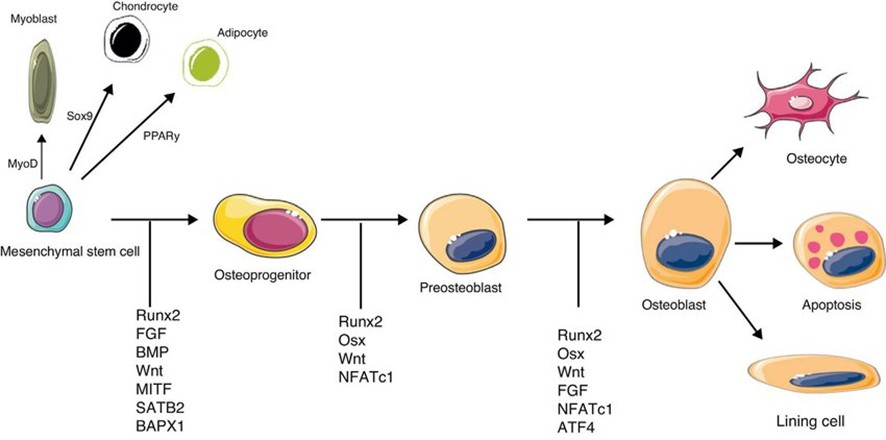Osteoblast Markers
Overview of Osteoblast Markers
Osteoblast markers play a key role in the differentiation of mesenchymal stem cells (MSCs) into osteoblasts (Arboleya L, et al., 2013). Osteoblasts are responsible for generating new bone tissue and are involved in skeletal repair and regeneration processes. In recent years, researchers have focused on identifying specific osteoblast markers that can also serve as differentiation factors of mesenchymal stem cells (MSCs) into osteoblasts. The identification of osteoblast markers has significantly advanced our understanding of the biology of osteoblasts and provided valuable tools for studying their behavior and function. Some of the commonly used markers include BMP, TGF-β, SDF-1, IGF-1, CDK1, Fucoidan, Runx2, and TAZ (Garg P, et al., 2017). These markers are specific in osteoblasts and can be detected using immunohistochemistry or molecular techniques. By utilizing these markers, researchers can track the differentiation of MSCs to osteoblasts and study the mechanisms behind it.
 Fig.1 Molecular signals with a key role in osteoblast differentiation and activation. (Arboleya L, et al., 2013)
Fig.1 Molecular signals with a key role in osteoblast differentiation and activation. (Arboleya L, et al., 2013)
Research Areas of Osteoblast Markers
Osteoblast (osteocyte) is an important cell type for new bone formation. The study of osteoblast markers plays an important role in understanding bone cell biology and provides key clues for the directed differentiation of mesenchymal stem cells (MSCs) into functional osteoblasts. The following are the research applications and potential value of osteoblast markers in different fields:
- Bone tissue engineering
Bone tissue engineering based on MSCs is a cutting-edge technology aimed at repairing and reconstructing bone defects. Using osteoblast markers, such as alkaline phosphatase (ALP), osteocalcin (BSP), and osteoblastic polypeptide (OPN), researchers can monitor the differentiation process of MSCs to osteoblasts, advance the study of the biological mechanism of osteogenesis, and provide technical support for the construction of more effective scaffolds and artificial bone substitutes for bone tissue engineering.
- Bone disease research
Bone diseases such as osteoporosis and impaired fracture healing have a serious impact on patients' quality of life. By studying osteoblast markers, such as nuclear transcription factor Runx2, alkaline phosphatase, and osteocalcin, we can gain insights into the functions and regulatory mechanisms of osteoblasts, providing important clues for finding new ways and drugs to treat bone-related diseases.
- Bone tumor research
Bone tumors are a group of diseases caused by uncontrolled proliferation of osteoblasts, such as osteosarcoma and bone cancer metastasis. The study of osteoblast markers helps to further understand the molecular mechanisms and signaling pathways involved in bone tumorigenesis and provides a basis for the development of targeted therapeutic approaches against bone tumors.
- Drug screening and toxicology research
Using MSCs, in vitro models can be established for screening osteogenesis-related drugs and evaluating the toxicity of compounds. Osteoblast markers such as ALP and osteocalcin can be used to monitor the success rate of MSCs differentiating into osteoblasts and osteogenic activity, providing reliable indicators for drug screening and toxicity assessment.
- Basic research on bone biology
Through the study of osteoblast markers, scientists can gain a deeper understanding of the molecular regulatory mechanisms of bone cell development, bone tissue metabolism, and bone growth, and reveal the biological nature of the skeletal system at the microscopic level, providing a theoretical basis for the treatment and prevention of bone-related diseases.
In conclusion, the study of osteoblast markers involves the fields of bone tissue engineering, bone diseases, drug screening and toxicology, bone tumors, and bone biology. Through an in-depth study of the function and regulatory mechanisms of the markers, we can better utilize the potential of MSCs to promote the recovery of bone function and progress in the treatment of bone diseases.
Reference:
- Fakhry M, Hamade E, Badran B, Buchet R, Magne D. Molecular mechanisms of mesenchymal stem cell differentiation towards osteoblasts. World J Stem Cells. 2013 Oct 26;5(4):136-48. doi: 10.4252/wjsc.v5.i4.136. PMID: 24179602; PMCID: PMC3812518.
- Garg P, Mazur M M, Buck A C, et al. Prospective review of mesenchymal stem cells differentiation into osteoblasts[J]. Orthopedic surgery, 2017, 9(1): 13-19.
- Arboleya L, Castañeda S. Osteoimmunology: the study of the relationship between the immune system and bone tissue[J]. Reumatología Clínica (English Edition), 2013, 9(5): 303-315.


